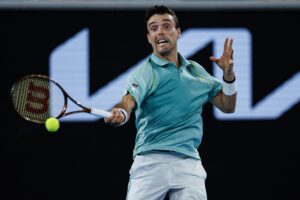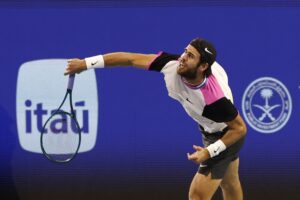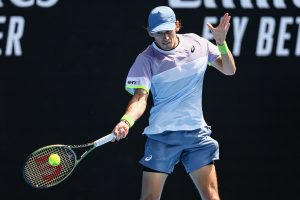Novak Djokovic certainly played exceptionally well in the Australian Open Men’s Singles Final. Djokovic himself thought that it was a virtually “perfect” performance and numerous tennis commentators and writers, including John Lloyd (a former Australian Open finalist himself), thought that it was the best performance they had ever seen and indeed had taken men’s tennis to a new level. But where exactly does Djokovic’s “djomination” of Rafael Nadal rank among the finest displays in Men’s Major Finals, and for that matter what constitutes a truly great display in a Major Final?
The most important ingredient of any truly great display in a Major Final is that it is against a truly great opponent, a man who is a champion himself and so not likely to give in easily (if at all), regardless of the quality of the tennis they are facing. Rafael Nadal, a 17-time Major winner, certainly fits that description, as indeed do all the other beaten men on this list. Above all, it is the undoubted quality of the opponent, and the apparent ease with which they are beaten, that constitutes a truly great performance in a Major Final.
Here, then are the five finest displays in Men’s Major Finals.
- RENÉ LACOSTE BEATS JEAN BOROTRA 6–4, 6–0, 6–4 IN THE 1926 US FINAL
There was, of course, tennis before the Open Era began in 1968 and there were several truly great displays in men’s finals in that pre-Open Era. Arguably the finest of them all was that of France’s René Lacoste against his compatriot Jean Borotra in the 1926 US Championship Final (as it was before the tournament was renamed the US Open in 1968).
Lacoste and Borotra were two of the four fabled “Musquetaires” who turned the world tennis order (one dominated by Britain and in particular the USA) on its head in the late 1920s and early 1930s, when they won a remarkable six Davis Cups in a row. In the process, they made France the tennis-crazy country it remains today, even if it is now nearly 40 years since a Frenchman last won a Major (Yannick Noah, who triumphed on home clay in 1983).
In 1926, however, the “Musquetaires” nickname had not yet been applied, because France would not win the first of its six successive Davis Cups until the following year. That year, Lacoste and Borotra, along with the other half of the famous foursome (Jacques Brugnon and Henri Cochet), were yet to forge the fearsome sense of unity that would sweep all before them in team tennis. Instead, they were still very much considered individuals, rather than as components of a larger team.
Both Lacoste and Borotra were already Major Champions (Lacoste had won both the French Open and Wimbledon in 1925, and Borotra had won Wimbledon in 1924), and so the US Open Final was regarded as something of a 50:50 affair. Lacoste, however, was having none of that. The first set was reasonably close, with a single break by Lacoste settling it. In the second, however, he was truly magnifique, as he bagelled Borotra 6-0. Borotra fought back in the third, but to no avail as Lacoste broke him yet again to win the match in straight sets.
- ROGER FEDERER BEATS LLEYTON HEWITT 6–0, 7–6(7–3), 6–0 IN THE 2004 US OPEN FINAL
Three of the four other entries on this list are from the last 15 years, as befits the era of “The Big Three”, or the “Trivalry” between Roger Federer, Rafael Nadal and Novak Djokovic. At different times, each one of them has produced a truly historic performance that has seemingly elevated men’s tennis to a whole new plane.
Of course, there are numerous examples that one could select for Roger Federer, such has been his unique combination of grace and power, especially from his absolute peak era of 2003 to 2008. In those five years, he won both Wimbledon and the US Open five times in a row, a feat that has never been matched in tennis history and that surely proves that at his best Federer was the finest attacking tennis player – one who thrived on the fastest surfaces, grass and hard-court – that the game has ever seen.
Of all Federer’s marvellous displays in Major Finals in that half-decade, surely the finest (and certainly the most statistically dominant) was his decimation of Lleyton Hewitt in the 2004 US Open Final, Federer’s first triumph in New York. In true revisionist style, it is often argued now that Federer thrived in that period because Nadal had yet to fully emerge (certainly on surfaces other than clay) and Djokovic did not win a Major of any kind until 2008. But that is to completely underestimate the stature of the Major champions who Federer faced in that period and still thrashed.
Foremost among them was Lleyton Hewitt, the Australian baseliner who is still regarded as one of the most ferocious competitors that tennis has ever seen. (Arguably, in the entire history of men’s tennis, only Jimmy Connors can match Hewitt for sheer fighting spirit.) And unlike Federer in 2004, Hewitt had already won the US Open, having memorably beaten the great Pete Sampras in straight sets in 2001, 7–6 (7–4), 6–1, 6–1. Unfortunately for Hewitt, that scoreline was almost exactly reversed when he faced Federer, who bagelled him in both the first and third sets, but even more importantly played tennis of a flair, guile and inventiveness that no other multiple Major-winner – not even his great rivals, Nadal and Djokovic – have ever come close to matching.
- RAFAEL NADAL BEATS ROGER FEDERER IN THE 2008 FRENCH OPEN FINAL 6–1, 6–3, 6–0
It is often said of adulterers, “If they can do it with you, they can do it to you” (meaning that no-one, not even their fellow adulterer, should ever trust them). Well, perhaps the same is true of the greatest tennis players, because just as Roger Federer destroyed Lleyton Hewitt in New York in 2004, so in turn was Federer himself destroyed by Rafael Nadal in the 2008 French Open Final.
Federer had already lost the previous two French Open Finals to Nadal, as well as a semi-final in 2005, but in each of those three matches he had at least been competitive, with each of them going to four sets. Indeed, in the very first set that the two men played in French Open Finals (in 2006), Federer actually played quite beautifully to win it 6-1. However, 2008 was completely different.
In 2008, Nadal was going for his fourth French title in a row and he was already being thought of as arguably the finest clay-court player ever. His performance in that final confirmed that status, as he blasted Federer off court in three sets, even bagelling him in the third. He was still only 21 at the time and at his most bull-like as a tennis player (before all the injuries began to slow him down), with his huge spinning forehands rearing up out of the red dirt at Federer like a succession of spitting mambas. Even the great Federer was powerless to prevent a complete clay-court annihilation and in the process he lost something of his aura of invincibility. Just over a month later at Wimbledon, when Nadal also beat him in the Final (albeit in a five-set classic, rather than a three-set whipping), that aura was gone forever.
TIED FIRST: NOVAK DJOKOVIC BEATS RAFAEL NADAL IN THE 2019 AUSTRALIAN OPEN FINAL 6-3, 6-2, 6-3; and JOHN McENROE BEATS JIMMY CONNORS IN THE 1984 WIMBLEDON FINAL 6–1, 6–1, 6–2
Novak Djokovic’s display against Rafael Nadal in the Australian Open Final last weekend was, without doubt, magnificent. It was precisely because he was playing Nadal, his greatest rival, and a fit and in-form Nadal to boot, that made his performance so memorable. Although Nadal hinted (no more than that) afterwards that his lack of match play in the previous four months had perhaps finally caught up with him, that takes nothing away from Djokovic, who first neutralised Nadal’s impressively remodelled serve and then served like a demon himself to reduce the great Spaniard to the status of a bystander for much of the match.
And yet there is one other performance in the history of men’s tennis that merits comparison with that of Djokovic in Melbourne, and it is that of John McEnroe in the 1984 Wimbledon Final against Jimmy Connors, when McEnroe not only beat his own greatest rival (at least after Bjorn Borg had retired) but rendered him almost powerless to do anything about it.
There are obvious comparisons between the two finals, even though they took place more than three decades apart. In both finals, the two men playing each other were unquestionably the two best players in the world at that time; both the men who ended up losing (Nadal and Connors) had already beaten their opponent (Djokovic and McEnroe respectively) in Major Finals; and both the losers appeared in the best of fettle going into the final. And yet the performances of Djokovic and McEnroe were both so impressive that, within minutes, both Finals appeared to be foregone conclusions (which, ultimately, they were).
There is one important distinction, however, between Djokovic in 2019 and McEnroe in 1984. As I have already mentioned, in the wake of Djokovic’s triumph in Melbourne, which could set him up for a calendar (i.e. real) Grand Slam, many fans and experts believed that they had seen the future of tennis, one that Djokovic, at least in the short term, would effortlessly dominate. Ironically, very similar sentiments were expressed at Wimbledon in 1984, when McEnroe beat Connors for the loss of only four games in three sets. And yet, in reality, what everyone saw that day was probably the end of something, rather than a new beginning. McEnroe would never win Wimbledon again (indeed, he only won one more Major, at the US Open a few months later) and because wooden rackets would be replaced by non-wooden rackets within a few years, McEnroe’s 1984 destruction of Connors would stand forever as the high-water mark of serve-and-volley play. McEnroe himself would argue that Pete Sampras was a better serve-and-volleyer than he had been, but Sampras, playing with a non-wooden racket, replaced McEnroe’s obvious artistry with jaw-dropping power.
Perhaps that is something for Novak Djokovic to contemplate. Just as McEnroe appeared invincible in 1984, so Djokovic appears unbeatable now. But as Shelley wrote in Ozymandias more than two centuries ago: “Look on my Works, ye Mighty, and despair!”
Main Photo:






